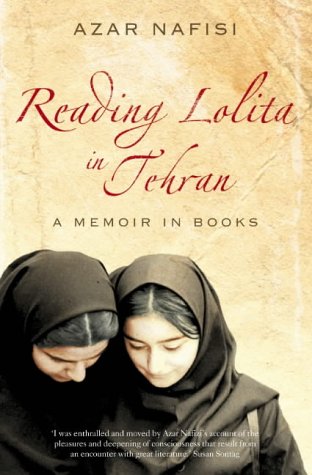‘Reading Lolita in Tehran‘ is a poignant, personal story penned beautifully by the author, Azar Nafisi, about her own life during the revolution in Iran, her own touching memories, her remembrance of these times interspersed with the books she taught in her classes in Iran. An engrossing book, a moving story that provides a glimpse into not only the political turmoil in Iran but the torment and anguish experienced by Nafisi herself and many of her students.
The story begins with Nafisi’s formation of a secret class that studies literature, discusses it and puts those stories into the context of their lives. The members were chosen by Nafisi-all were females, former students who showed great interest and enthusiasm about literature. The narration then reverts back into the past, recording Nafisi’s early days, first in the U.S. and then when she returns to Iran-the beginning of strife, dissent and the eventual establishment of the revolution over the country. In this way, the story gives the reader a more intimate glimpse(although a one sided glimpse) into life during those times-an intimacy that no reporting could ever hope to accomplish. The novel ends with Nafisi going back to the U.S. with her husband and two children, leaving behind her secret classes with whom she had so personally become involved, yet persistently aiming to cherish those beautiful memories even after she leaves Iran.
As the title suggests-‘Reading Lolita in Tehran-A Memoir In Books,’ its a memoir but not just any memoir but rather a memoir that looks at her life through the lens of several literary books penned by Nabokov,Austen, Fitzgerald and James. Therefore, one condition for readers of this novel is that they should have a passion for literature, to comprehend literature’s ability to help people deal with their real life and gauge its shortcomings, only then will he reader appreciate the books and understand why Nafisi so effortlessly mixes her real world with that of the literary. Otherwise the book will appear like a sordid literature class, which is not Nafisi’s intention. Having read the books by the aforementioned authors will further widen the reader’s understanding of the interspersing of literary and real lives that Nafisi had incorporated in the book. ‘Reading Lolita in Tehran‘ is not just about her students, her secret classes and her life but also about how literature affects them and how it enables them to know each other and their lives better, allows them to live more freely etc.
The book also helps us to know the different views people held about the Islamic Republic of Iran, about the revolution, about the veil, about Ayatollah Khomeini etc. These opinions could be interpreted anyway that the reader wishes them though some are heavily colored by Nafisi’s own judgment. For example,initially, there is a constant repetition of the curtailment of women’s rights specifically of being forced to wear the burkha/veil/chador. Nafisi mentions it in almost every sentence which is unnatural, almost like the publisher forced her to perpetually put them in along with her story so that it not only enlarges their suffering but also reinforces the West’s idea of how backward Islam is and how it must go and save these women from such atrocities. Its only later on that such repetitions reduce, that she begins giving concrete reasons for her defiant opposition to the rule forcing her to wear her veil. It is only then that the reader can see a broader context to the whole issue. Nafisi was clearly against the totalitarian regime that the revolution ushered in that clamped down on women’s rights as well as freedom of expression and this is manifested in the book lucidly.
The parallels that Nafisi manages to make between their life in Iran and the great literary works shows her unbridled passion for literature. The novel is thus in parts a story narrating the author’s personal life before, during and after the revolution and in parts it is like a literature class fascinating in its own rights for it broadens the reader’s horizons of great works of English literature in an Iranian context.
‘Reading Lolita in Tehran‘ is a mesmerizing recollection of a life steeped in the love of literature and in inculcating and encouraging that love in other fellow students, in making others including the readers, see that literature’s role in real life is far more valuable then we believe.

